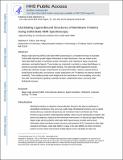Elucidating ligand-bound structures of membrane proteins using solid-state NMR spectroscopy
Author(s)
Elkins, Matthew Ryan; Hong, Mei
DownloadAccepted version (826.1Kb)
Publisher with Creative Commons License
Publisher with Creative Commons License
Creative Commons Attribution
Terms of use
Metadata
Show full item recordAbstract
Magic-angle-spinning (MAS) solid-state NMR spectroscopy is a versatile technique to elucidate functionally important protein–ligand interactions in lipid membranes. Here, we review recent solid-state NMR studies of membrane protein interactions with cholesterol, lipids, transported substrates, and peptide ligands. These studies are conducted in synthetic or native lipid bilayers to provide an accurate environment for ligand binding. The solid-state NMR approaches include multinuclear detection to gain comprehensive structural information, distance measurements to locate ligand-binding sites, and dynamic nuclear polarization and 1 H detection to enhance spectral sensitivity. These studies provide novel insights into the mechanisms of virus budding, virus entry into cells, transmembrane signaling, substrate transport, antibacterial action, and many other biological processes.
Date issued
2019-08Department
Massachusetts Institute of Technology. Department of ChemistryJournal
Current Opinion in Structural Biology
Publisher
Elsevier BV
Citation
Elkins, Matthew R. and Mei Hong. “Elucidating ligand-bound structures of membrane proteins using solid-state NMR spectroscopy.” Current Opinion in Structural Biology, 57 (August 2019): 103–109 © 2019 The Author(s)
Version: Author's final manuscript
ISSN
0959-440X